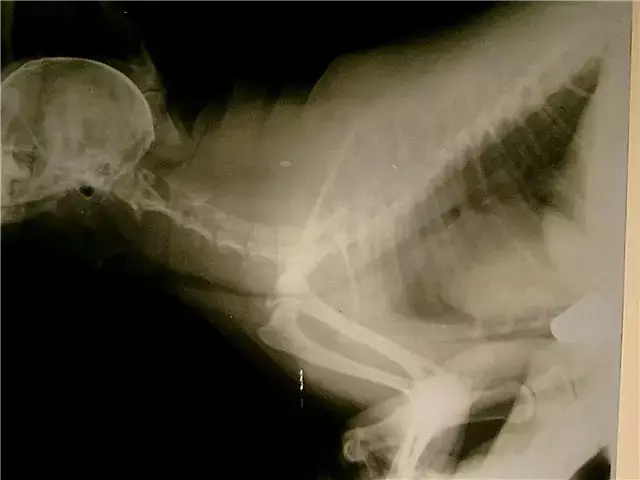- Author Rachel Wainwright [email protected].
- Public 2023-12-15 07:39.
- Last modified 2025-11-02 20:14.
L-dopa
Instructions for use:
- 1. Pharmacological action
- 2. Indications for use
- 3. Contraindications to admission
- 4. Methods and features of reception
- 5. Side effects from taking

L-dopa is an antiparkinsonian agent.
The active ingredient of the drug is a dopamine precursor - levodopa (levorotatory isomer of DOPA).
Pharmacological action of L-dopa
By providing antiparkinsonian effects, levodopa removes manifestations such as:
- hypokinesia;
- rigidity;
- increased salivation and salivation;
- tremor;
- dysphagia.
The effect of taking the drug L-Dopa is achieved due to the fact that levodopa is transformed into dopamine directly in the central nervous system of the body, thereby replenishing the deficiency of this neurotransmitter in the central nervous system.
Levodopa is mostly converted to dopamine in peripheral tissues. The dopamine obtained here does not take part in the anti-Parkinsonian effect on the body and is mainly responsible for the side effects from taking levadopa. For this reason, it is customary to prescribe levadopa in combination with other drugs that inhibit peripheral dopa decarboxylase. Thanks to this, you can reduce the dosage of levadopa and the side effects from taking it.
The results of taking L-dopa can be observed in a patient 6-8 days after starting the course of treatment. The positive effect manifests itself on an increasing basis, reaching its peak on the 25-30th day.
Indications for the use of L-dopa
L-dopa is effective in the treatment of Parkinson's disease and Parkinson's syndrome (except when this syndrome is caused by antipsychotic drugs).
Contraindications for admission
L-dopa has a number of contraindications. So, the drug cannot be prescribed by a doctor in cases where at least one of the following factors is present:
- hypersensitivity to its components;
- pregnancy;
- lactation period;
- the patient is a child under 12 years of age.
Also, L-dopa is not prescribed if therapeutic therapy includes MAO inhibitors.
By decision of the doctor and with caution, it is allowed to take the drug when:
- diseases of the kidneys, liver, endocrine system, lungs;
- psychosis;
- angle-closure glaucoma and predisposition to it;
- open-angle glaucoma of the chronic type;
- diseases of the heart and blood vessels;
- hepatic and / or renal failure;
- melanoma;
- states when depression of the central nervous system is observed;
- convulsive seizures;
- bronchial asthma and pulmonary emphysema;
- gastric ulcer and diseases of the duodenum;
- myocardial infarction (including history, including in combination with arrhythmias of various types);
heart rhythm disorders
Methods and features of reception
The capsules of the drug are taken orally during meals, swallowing whole and drinking a small amount of liquid.
L-dopa is taken from the minimum prescribed dose, gradually increasing it based on the individual characteristics of the patient's body. The initial daily dose, which is taken in 2-3 visits, is 0.25-1 g. It is increased by 0.125-0.75 g at regular intervals (2-3 days). The decision to increase should be made by the attending physician, focusing on the patient's individual sensitivity to the drug L-dopa. The maximum allowable daily dose should not exceed 8 g.
Cancellation of L-dopa intake is carried out gradually, since with an abrupt termination of the course of treatment, negative consequences are possible, expressed in manifestations of symptoms similar to that inherent in neuroleptic malignant syndrome.
Patients for whom the dose of the drug was for some reason reduced or the course of treatment with L-dopa was discontinued should be monitored constantly.
During the entire course of treatment, monitoring of the patient's blood test parameters and his mental status is required.
If the patient has angle-closure glaucoma, constant monitoring of intraocular pressure is necessary.
If a surgical intervention involving the use of general anesthesia is necessary, stop drinking L-Dopa 48-72 hours before the operation.
During a long course of treatment with L-dopa, control of the functioning of all organ systems of the body is required.

Eating food with a high protein content impairs the absorption of the drug.
L-Dopa helps to reduce attention, concentration, worsens psychomotor reactions. Therefore, during the periods when the course of treatment is carried out, it is necessary to be careful with motor vehicle drivers, people employed in potentially hazardous industries.
Side effects from taking L-dopa
Taking the drug L-dopa can cause side effects, manifested by:
- from the gastrointestinal tract (vomiting, nausea, constipation, ulceration of the gastric mucosa, dysphagia, loss of appetite, bleeding in the stomach and intestines, etc.);
- from the side of the central nervous system (dizziness, anxiety, sleep disorder, paranoia, euphoric states, depression, convulsions, manifestations of uncontrolled movements, etc.);
- disorders of the heart and blood vessels (decreased blood pressure, arrhythmia, tachycardia, orthostatic collapse, etc.);
- disorders of the hematopoietic organs (leukopenia, thrombocytopenia);
- in the form of polyuria, less often - diplopia.
Information about the drug is generalized, provided for informational purposes only and does not replace the official instructions. Self-medication is hazardous to health!






